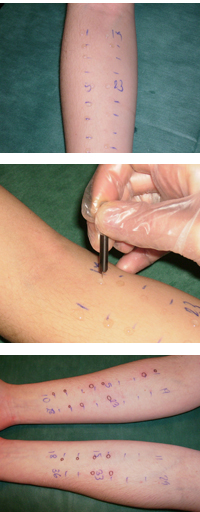Unidad de Inmunología y Alergia Teknon
What is atopic dermatitis?
The causes of atopic dermatitis (AD) include genetic and constitutional factors with modification of the type of inflammatory response and alterations in essential fatty acids (omega-6), with frequent bacterial superinfection of the skin by Staphylococcus aureus and an exaggerated response to environmental pollutants.
About 80% of children with atopic dermatitis (AD) present respiratory allergy and some of them also present food allergy. Therefore, atopic dermatitis is a complex, multifactorial disease that requires a complete and exhaustive allergological study
How is atopic dermatitis diagnosed?

Prick testTo determine the allergic factors that trigger or worsen atopic dermatitis (AD), skin tests with food and inhalants should be performed, which can be complicated to perform if the patient is in an acute inflammatory phase. These tests include prick tests and delayed-reading (48 hours) epicutaneous tests.
Blood tests usually show positive allergy markers (IgE) and in many cases specific IgE or IgG antibodies are detected.
As some foods are sometimes implicated in the reaction, elimination diets involving the exclusion for a certain period of time (or permanently) of foods such as cow's milk, egg or others are necessary. When in a diagnostic phase, it is common to perform controlled provocation tests by reintroducing the suspected foods to check whether the symptoms are reproduced.
There are several study protocols of varying degrees of complexity, which always require a high dose of time and patience for patients, parents of sick children and physicians, who must always maintain close communication with those affected, making all the necessary explanations about the process.
What is the treatment of atopic dermatitis?
The treatment of atopic dermatitis consists of knowing the allergens that cause it, and determining the possible superinfections and irritants that exacerbate the disease.
The main anti-allergic treatment consists of suppressing or minimizing the allergen. This is possible in food allergy (milk, egg, soy, wheat, etc.) and not so much in the case of inhalants (mites, fungi, pollens).
Another important aspect is to eliminate infections once proven with the use of antibiotics or antiseptics. Also eliminate the use of irritants such as wool fibers, some perfumes, detergents and fabric softeners, etc.
The treatment of dry skin (xerosis) requires avoiding soap in baths, immediately moisturizing the skin with emollient creams, avoiding scratching. If itching is very intense, some antihistamines such as hydroxyzine can be used.
Inflammation is corrected with the use of topical corticosteroids, but it should be remembered that their continued use in some areas of sensitive skin (face, genitals, folds) may cause adverse effects. There are different creams, ointments and ointments of different potency, which should always be used under medical supervision.
In recent years topical creams have been developed with products that have an anti-inflammatory effect without the side effects of corticosteroids (tacrolimus and pimecrolimus), however the adverse effects of their long-term administration are not well known.
Other treatments can be considered according to the evolution and severity of AD (phototherapy with UVA or UVB, cyclosporine A, anti-leukotrienes, immunoglobulins). It is necessary to warn about the possible adverse effects of some so-called "natural" medicines with herbs, essential oils and others whose efficacy and safety have not been evaluated.
| Morning | Afternoon | |
|---|---|---|
| Monday | 9.00 - 19.30 h | - |
| Tuesday | 9.00 - 19.30 h | - |
| Wednesday | 9.00 - 19.30 h | - |
| Thursday | 9.00 - 19.30 h | - |
| Friday | 9.00 - 14.00 h | - |















